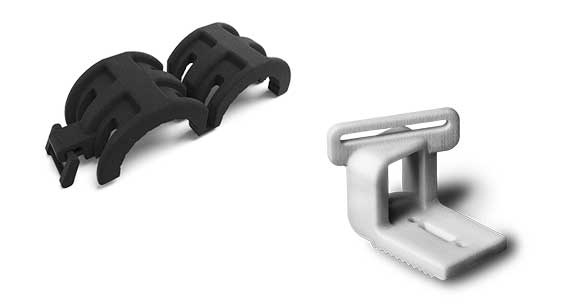MJF vs. SLS: A Comparison of Polyamide 3D Printing Technologies

3D printing’s capabilities continue to evolve with the introduction of HP’s all-new technology, Multi Jet Fusion. This additive manufacturing process takes a unique approach to building parts from thermoplastic nylon powder, which results in faster build times, improved precision, and more consistent mechanical properties throughout the part.
If you’re thinking this process sounds awfully similar to selective laser sintering (SLS), you’re not wrong. But, there are some differences between the technologies that should be understood before making your manufacturing selection.
How Multi Jet Fusion Builds Parts
Multi Jet Fusion uses an inkjet array to selectively apply fusing and detailing agents across a bed of nylon powder, which are fused by heating elements into a solid. After a layer is built, a fresh layer of powder is distributed on top of the previous layer and the next phase continues until the part is complete.
The process utilizes an engineering-grade nylon 12 powder, so parts are durable and suitable for functional testing and end use. Multi Jet Fusion's accelerated build speed ultimately leads to reduced manufacturing costs.
A Side-by-Side Comparison
Multi Jet Fusion doesn’t entirely replace SLS, though. Your part requirements such as feature resolution, surface finish, materials, colors, mechanical properties, and color will ultimately determine the best process for your application.
Feature Resolution. Multi Jet Fusion parts will have a finer feature resolution of 0.020 in. compared to 0.030 for SLS. Although, it should be noted that SLS has better small feature accuracy of ±0.001 over ±0.004 in. for Multi Jet Fusion. If a smooth surface finish is a requirement, Multi Jet Fusion will be better choice than SLS. But we recommend secondary operations for both processes, if surface finishes are crucial to your application.
Materials and Colors. SLS will provide you with a broader range of options with multiple nylons as well as a TPU for elastomeric prototyping. And, SLS parts can be dyed a variety of colors. Currently, Multi Jet Fusion only offers part built in Nylon 12. These parts come off the platform as grey, but can be dyed black for improved cosmetics.
| Material Property | Multi Jet Fusion - PA 12 | SLS - PA 650 | SLS - PA 850 |
|---|---|---|---|
|
Heat Deflection |
205-350°F (95-175°C) |
186-350°F (86-177°C) |
118-370°F (48-188°C) |
|
Tensile Strength |
6960 psi (48 MPa) |
6,962 psi (48 MPa) |
6,050-6,946 psi (42-48 MPa) |
|
Elongation at Break |
15-20% |
24% |
14-51% |
Mechanical Properties. The unique way in which Multi Jet Fusion builds parts results in more consistent mechanical properties along all directions of the part’s geometry. We highly recommend Multi Jet Fusion, if you have key features on multiple surfaces and need uniform mechanical properties throughout your part.
Part Size. Another important consideration is part size. SLS still provides you a larger build envelope of 19 in. by 19 in. by 17 in. Multi Jet Fusion’s build envelope is slightly smaller at 14.9 in. by 14.9 in. by 11.1 in.
Part Quantities. As mentioned earlier, Multi Jet Fusion offers accelerated build speed, which means it can support larger quantities in a shorter time frame. Delivery will generally be one to three days.
More Multi Jet Fusion Information
If you have more questions regarding the Multi Jet Fusion process, visit our design guidelines page or contact our applications engineers at [email protected].